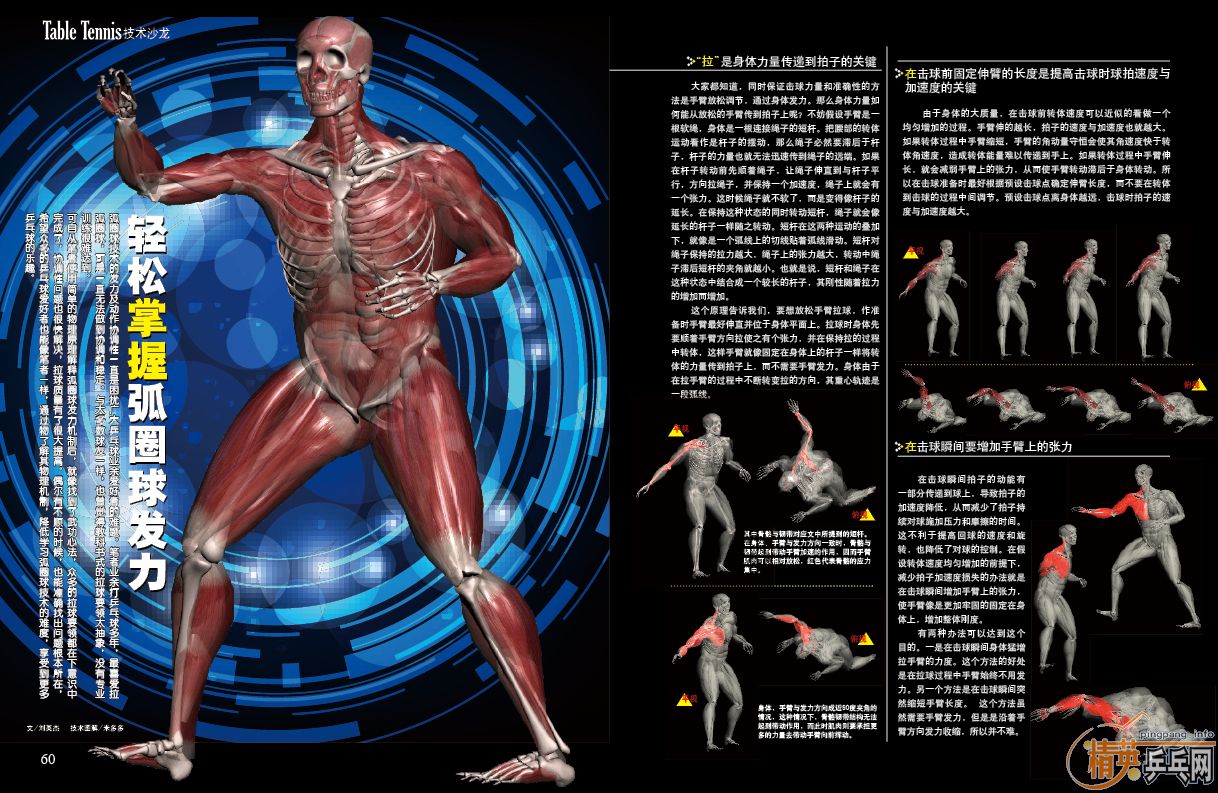
Table Tennis Magazines (《乒乓》杂志), February, 2011, Page 60.
Translation
Simplified Physics behind a Powerful Forehand Loop in Table Tennis
By Yingjie Liu (刘英杰).
Technical Editor: Mi Duo Duo (米多多).
(1) The "pulling force" is the key for the conduction of a player's body force to
his paddle.
It's well known that to attain both power and accuracy in a stroke, a player
should use his body force to power the stroke while keeping his arm relaxed
for fine control. How is it possible to have the body force conducted through the relaxed
arm to the paddle ? Let's assume the player's arm is a flexible rope and the body
is like a short stick with one end attached to the end of the rope. Think of the
body rotation as the rotation of the stick (w.r.t its midpoint). Then there will be a significant
lag for the rope. Therefore the rotation of the stick can not be conducted
to the far end of the rope immediately. Now let's try another experiment. First
align the rope with the stick. Before rotating the stick, let the stick pull the rope
in their direction, and maintain an acceleration
movement. Then there is a tension created along the rope (since it has mass). And the rope
now behaves more like the extension of the stick rather than a flexible rope.
While keeping this movement, we rotate the short stick. Then the short stick
and the rope will move together like a long stick. The short stick under the
superposition of the two movements looks like a tangent line segment sliding along a
circular curve. The more pulling force the short stick is acting on the rope with, the more
tension is created along the rope and the smaller is the lag angle between the stick
and the rope. In other words, the stick and the rope can be viewed as a long stick
under the circumstances, and the stiffness of the long stick increases with more pulling force.
From this experiment we know that in order to loop with a relaxed arm, it's better
to straighten the arm and place it on the same surface of the upper body during preparation.
When starting to loop, the upper body first pulls the arm along its direction to create
a tension in the arm, then the upper body rotates while keeping the pulling action.
The arm then moves as if it were fixed to the body, thus quickly conducting the action
to the paddle with relaxed arm muscles. Since the body pulls the arm in a continuously
changing direction, the trajectory of its gravity center is a curve.
(2) Keeping the extended arm length fixed before hitting the ball is important for improving
the speed and acceleration of the paddle.
Due to the relatively large mass of the body, the angular speed of the body
during a stroke is considered smoothly increasing before hitting the ball. Therefore the farther
is the arm extended away from the body, the greater are the speed and acceleration of
the paddle. If the player shortens the arm in the middle of a stroke before hitting the ball,
the conservation of angular momentum will cause the arm to rotate faster than the
body temporarily, thus interrupting the energy transfer from the body. On the other hand,
if the player is extending his arm during a stroke, the tension in the arm will be reduced
which causes the lag of the arm from the body rotation. Therefore, the player should
fix his extended arm length (according to the
incoming ball prediction) during a stroke before hitting the ball.
(3) The tension in the arm should be raised at the moment of hitting the ball.
When the paddle hits the ball its kinetic energy is reduced, which shortens the
time the paddle could have used to push and create spin on the ball, and also reduces the
control to the ball. With the assumption of smoothly increasing angular speed of the body
during the stroke, the strategy for reducing the kinetic energy loss of the paddle is to
suddenly raise the tension in the arm, so that the arm and the body can be virtually
bonded together more tightly, increasing the overall rigidity. There are two ways
to achieve this goal. One is to suddenly increase the pulling force the body acts
on the arm. The advantage of this method is that the entire stroke
uses essentially no force from arm muscles. The other way is to suddenly shorten
the extended arm length when hitting the ball, thus increasing the tension along the
arm. This method uses arm force along the direction of the arm, so it's also
not difficult to do.

